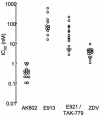Spirodiketopiperazine-based CCR5 inhibitor which preserves CC-chemokine/CCR5 interactions and exerts potent activity against R5 human immunodeficiency virus type 1 in vitro
- PMID: 15280474
- PMCID: PMC479103
- DOI: 10.1128/JVI.78.16.8654-8662.2004
Spirodiketopiperazine-based CCR5 inhibitor which preserves CC-chemokine/CCR5 interactions and exerts potent activity against R5 human immunodeficiency virus type 1 in vitro
Abstract
We identified a novel spirodiketopiperazine (SDP) derivative, AK602/ONO4128/GW873140, which specifically blocked the binding of macrophage inflammatory protein 1alpha (MIP-1alpha) to CCR5 with a high affinity (K(d) of approximately 3 nM), potently blocked human immunodeficiency virus type 1 (HIV-1) gp120/CCR5 binding and exerted potent activity against a wide spectrum of laboratory and primary R5 HIV-1 isolates, including multidrug-resistant HIV-1 (HIV-1(MDR)) (50% inhibitory concentration values of 0.1 to 0.6 nM) in vitro. AK602 competitively blocked the binding to CCR5 expressed on Chinese hamster ovary cells of two monoclonal antibodies, 45523, directed against multidomain epitopes of CCR5, and 45531, specific against the C-terminal half of the second extracellular loop (ECL2B) of CCR5. AK602, despite its much greater anti-HIV-1 activity than other previously published CCR5 inhibitors, including TAK-779 and SCH-C, preserved RANTES (regulated on activation normal T-cell expressed and secreted) and MIP-1beta binding to CCR5(+) cells and their functions, including CC-chemokine-induced chemotaxis and CCR5 internalization, while TAK-779 and SCH-C fully blocked the CC-chemokine/CCR5 interactions. Pharmacokinetic studies revealed favorable oral bioavailability in rodents. These data warrant further development of AK602 as a potential therapeutic for HIV-1 infection.
Figures







Similar articles
-
TAK-652 inhibits CCR5-mediated human immunodeficiency virus type 1 infection in vitro and has favorable pharmacokinetics in humans.Antimicrob Agents Chemother. 2005 Nov;49(11):4584-91. doi: 10.1128/AAC.49.11.4584-4591.2005. Antimicrob Agents Chemother. 2005. PMID: 16251299 Free PMC article. Clinical Trial.
-
Potent anti-R5 human immunodeficiency virus type 1 effects of a CCR5 antagonist, AK602/ONO4128/GW873140, in a novel human peripheral blood mononuclear cell nonobese diabetic-SCID, interleukin-2 receptor gamma-chain-knocked-out AIDS mouse model.J Virol. 2005 Feb;79(4):2087-96. doi: 10.1128/JVI.79.4.2087-2096.2005. J Virol. 2005. PMID: 15681411 Free PMC article.
-
Design, synthesis, and biological evaluation of the combinatorial library with a new spirodiketopiperazine scaffold. Discovery of novel potent and selective low-molecular-weight CCR5 antagonists.J Med Chem. 2006 Jul 13;49(14):4140-52. doi: 10.1021/jm060051s. J Med Chem. 2006. PMID: 16821774
-
HIV chemokine receptor inhibitors as novel anti-HIV drugs.Cytokine Growth Factor Rev. 2005 Dec;16(6):659-77. doi: 10.1016/j.cytogfr.2005.05.009. Epub 2005 Jul 6. Cytokine Growth Factor Rev. 2005. PMID: 16005254 Review.
-
Vicriviroc, a new CC-chemokine receptor 5 inhibitor for treatment of HIV: properties, promises and challenges.Expert Opin Drug Metab Toxicol. 2010 Sep;6(9):1139-50. doi: 10.1517/17425255.2010.510833. Expert Opin Drug Metab Toxicol. 2010. PMID: 20712521 Review.
Cited by
-
GRL-02031, a novel nonpeptidic protease inhibitor (PI) containing a stereochemically defined fused cyclopentanyltetrahydrofuran potent against multi-PI-resistant human immunodeficiency virus type 1 in vitro.Antimicrob Agents Chemother. 2009 Mar;53(3):997-1006. doi: 10.1128/AAC.00689-08. Epub 2008 Oct 27. Antimicrob Agents Chemother. 2009. PMID: 18955518 Free PMC article.
-
Discovery of 4-[4-({(3R)-1-butyl-3-[(R)-cyclohexyl(hydroxy)methyl]-2,5-dioxo-1,4,9-triazaspiro[5.5]undec-9-yl}methyl)phenoxy]benzoic acid hydrochloride: a highly potent orally available CCR5 selective antagonist.Bioorg Med Chem. 2011 Jul 1;19(13):4028-42. doi: 10.1016/j.bmc.2011.05.022. Epub 2011 May 20. Bioorg Med Chem. 2011. PMID: 21658961 Free PMC article.
-
Closing the door to human immunodeficiency virus.Protein Cell. 2013 Feb;4(2):86-102. doi: 10.1007/s13238-012-2111-9. Epub 2013 Mar 12. Protein Cell. 2013. PMID: 23479426 Free PMC article. Review.
-
Biased and constitutive signaling in the CC-chemokine receptor CCR5 by manipulating the interface between transmembrane helices 6 and 7.J Biol Chem. 2013 May 3;288(18):12511-21. doi: 10.1074/jbc.M112.449587. Epub 2013 Mar 14. J Biol Chem. 2013. PMID: 23493400 Free PMC article.
-
Reduced maximal inhibition in phenotypic susceptibility assays indicates that viral strains resistant to the CCR5 antagonist maraviroc utilize inhibitor-bound receptor for entry.J Virol. 2007 Mar;81(5):2359-71. doi: 10.1128/JVI.02006-06. Epub 2006 Dec 20. J Virol. 2007. PMID: 17182681 Free PMC article.
References
-
- Baba, M., O. Nishimura, N. Kanzaki, M. Okamoto, H. Sawada, Y. Iizawa, M. Shiraishi, Y. Aramaki, K. Okonogi, Y. Ogawa, K. Meguro, and M. Fujino. 1999. A small-molecule, nonpeptide CCR5 antagonist with highly potent and selective anti-HIV-1 activity. Proc. Natl. Acad. Sci. USA 96:5698-5703. - PMC - PubMed
-
- Dean, M., M. Carrington, C. Winkler, G. A. Huttley, M. W. Smith, R. Allikmets, J. J. Goedert, S. P. Buchbinder, E. Vittinghoff, E. Gomperts, S. Donfield, D. Vlahov, R. Kaslow, A. Saah, C. Rinaldo, R. Detels, and S. J. O'Brien. 1996. Genetic restriction of HIV-1 infection and progression to AIDS by a deletion allele of the CKR5 structural gene. Hemophilia Growth and Development Study, Multicenter AIDS Cohort Study, Multicenter Hemophilia Cohort Study, San Francisco City Cohort, ALIVE Study. Science 273:1856-1862. - PubMed
-
- Dragic, T., A. Trkola, D. A. Thompson, E. G. Cormier, F. A. Kajumo, E. Maxwell, S. W. Lin, W. Ying, S. O. Smith, T. P. Sakmar, and J. P. Moore. 2000. A binding pocket for a small molecule inhibitor of HIV-1 entry within the transmembrane helices of CCR5. Proc. Natl. Acad. Sci. USA 97:5639-5644. - PMC - PubMed
-
- Evans, E. A. 1974. Catalytic exchange in solution, p. 271-317. In Tritium and its compounds. Wiley and Sons, New York, N.Y.
-
- Fauci, A. S. 2003. HIV and AIDS: 20 years of science. Nat. Med. 9:839-843. - PubMed
Publication types
MeSH terms
Substances
LinkOut - more resources
Full Text Sources
Other Literature Sources
Medical
Miscellaneous

